Tirunageswaram Sri Naganathar ( Rahu Navagrahastalam) Temple, Thanjavur

Address
Sri Naganathar Temple, Thirividaimarudhur, Thirunageswaram, Thanjavur, Tamil Nadu 612204
Diety
Nageswarar , Naganathar
Introduction
Tirunageswaram Naganathar Temple also known as Rahu Stalam is a Hindu temple dedicated to the deity Shiva, located in Tirunageswaram, a village in the outskirts of Kumbakonam, a town in Tamil Nadu, India. It is significant to the Hindu sect of Saivism as one of the temples associated with the nine planet elements, the Navagraha Stalas, and specifically Rahu. Shiva is worshiped as Naganathar, and is represented by the lingam. His consort Parvati is depicted as Piraisoodi Amman. The presiding deity is revered in the 7th century Tamil Saiva canonical work, the Tevaram, written by Tamil saint poets known as the nayanars and classified as Paadal Petra Sthalam. It houses four gateway towers known as gopurams. The temple has numerous shrines, with those of Naganathar, Rahu and Piraisoodi Amman being the most prominent. The temple complex houses many halls; the most notable is the ornamental entrance hall built during the Nayak period.
Puranic Significance
Thirunageswaram is one of the many temple towns in the state which is named after the grooves, clusters or forests dominated by a particular variety of a tree or shrub and the same variety of tree or shrub sheltering the presiding deity. The region is believed to have been covered with Chamapaka forest and hence called ChamapakavanamMany serpents, including Adishesha, Takshaka and Karkotaka, worshipped Shiva at this place, leading to the name “Tirunageswaram”. As per Hindu legend, the king of snakes, Adisesha did penance at this place, called Senbaranya Kshetram on account of the presence of large number of Senbaga trees. Shiva was pleased by the penance and appeared to him. Since Shiva gave a boon to the king of Serpents, he is called Naganathar. A Goddess Girigujambal is believed to be worshipping Shiva here with goddesses Lakshmi, Saraswathi, Ganesha, Muruga, and Shasta. Maha Bhairava is still believed to be guarding and assisting the divine mother during her prayers. The Goddess is said to be Swayambu as she is present in the form of Meru. Hence, no abhishekam (ablution) is performed for the image. As per a Hindu legend, Indra was cursed by sage Gautama as he misbehaved with the latter’s wife Ahalya. To obtain deliverance from the sage’s curse, it is said that Indra worshipped Giri-Gujambigai with a scented material termed Punugu for 45 days. Sages like Gautama and Parashara and kings like Bhagiratha and Nala are said to have worshipped Naganathar at this place.
Beliefs
As per belief, people troubled by Sarpa-dosha or Malefic effects Rahu-Kethu seek a relief by offering prayers in a single day to Kudanthai or Kumbakonam Nageshwarar in the morning, Thirunageshwaram Naganathar at the noon, Thirupamburam Pambureswarar in the evening and Nagoor Nageshwarar or Naganathar temple at night.
Special Features
The temple is another masterpiece which exhibits the Chola style of architecture. It is believed to have been built by Aditya Chola I in the 10th century A.D. Later rulers have modified the temple with their own additions. The temple has a separate shrine for Rahu. The temple is located on the southern bank of the river Kaveri 7 km from Kumbakonam. The temple campus encompasses exclusive shrines for Naganatha Swamy (Shiva), Pirayani Amman (Parvathi), Giri-Gujambigai (Parvathi) and Rahu with his divine spouses. Goddess Girigujambal has a separate shrine inside the temple campus as it is believed that the goddess is in thava kolam (mode of deep penance) The temple tank is located in the southern side and has a hundred pillared hall. The second precinct has a granite floor and enshrines the Rahu shrine in the north eastern corner. The path leading to the main shrine in the second precinct has a hall decorated with Nayak style pillars with yalis. The hall was constructed by Govinda Dikshitar, the minister of successive Nayak rulers, Achuthappa Nayak (1560–1614) and Raghunatha Nayak (1600–34). In the front hall on the eastern side, artistic pillar with “older and nine horses” design is found, while similar pillars are found on the southern side as well. There is a hall in the northern side with pillars decorated with yalis used for staging idols during the festive occasions. The renovation work in the western walls was done during 1929 with artistic inscriptions. In the path way to main shrine, there are art works depicting Veda nayakas, king Sambumali and penance pose of Ambal. The Dwarapalaga images on each side at the entrance of Naganathar shrine are made of chunam clay.
Festivals
Brahmotsavam at this temple occurs during the Tamil month of Karthigai (November-December). Processions of the temple deities and divine marriage ceremonies are conducted during this festival. Another major festival at this temple is the Kanda Sashti that celebrates Lord Murugan, son of Shiva.
Century/Period/Age
1000-2000 years
Managed By
Hindu Religious and Charitable Endowments (HRCE)
Nearest Bus Station
Tirunageswaram
Nearest Railway Station
Thanjur
Nearest Airport
Trichy









